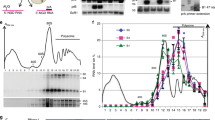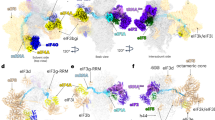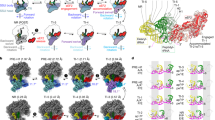Abstract
No-go decay (NGD) targets mRNAs with stalls in translation elongation for endonucleolytic cleavage in a process involving the Dom34 and Hbs1 proteins. The crystal structure of a Schizosaccharomyces pombe Dom34–Hbs1 complex reveals an overall shape similar to that of eRF1–eRF3–GTP and EF-Tu–tRNA–GDPNP. Similarly to eRF1 and GTP binding to eRF3, Dom34 and GTP bind to Hbs1 with strong cooperativity, and Dom34 acts as a GTP-dissociation inhibitor (GDI). A marked conformational change in Dom34 occurs upon binding to Hbs1, leading Dom34 to resemble a portion of a tRNA and to position a conserved basic region in a position expected to be near the peptidyl transferase center. These results support the idea that the Dom34–Hbs1 complex functions to terminate translation and thereby commit mRNAs to NGD. Consistent with this role, NGD at runs of arginine codons, which cause a strong block to elongation, is independent of the Dom34–Hbs1 complex.
This is a preview of subscription content, access via your institution
Access options
Subscribe to this journal
Receive 12 print issues and online access
$189.00 per year
only $15.75 per issue
Buy this article
- Purchase on Springer Link
- Instant access to full article PDF
Prices may be subject to local taxes which are calculated during checkout







Similar content being viewed by others
References
Doma, M.K. & Parker, R. RNA quality control in eukaryotes. Cell 131, 660–668 (2007).
Isken, O. & Maquat, L.E. Quality control of eukaryotic mRNA: safeguarding cells from abnormal mRNA function. Genes Dev. 21, 1833–1856 (2007).
Maquat, L.E. Nonsense-mediated mRNA decay: splicing, translation and mRNP dynamics. Nat. Rev. Mol. Cell Biol. 5, 89–99 (2004).
van Hoof, A., Frischmeyer, P.A., Dietz, H.C. & Parker, R. Exosome-mediated recognition and degradation of mRNAs lacking a termination codon. Science 295, 2262–2264 (2002).
Frischmeyer, P.A. et al. An mRNA surveillance mechanism that eliminates transcripts lacking termination codons. Science 295, 2258–2261 (2002).
Doma, M.K. & Parker, R. Endonucleolytic cleavage of eukaryotic mRNAs with stalls in translation elongation. Nature 440, 561–564 (2006).
Passos, D.O. et al. Analysis of Dom34 and its function in no-go decay. Mol. Biol. Cell 20, 3025–3032 (2009).
Gandhi, R., Manzoor, M. & Hudak, K.A. Depurination of Brome mosaic virus RNA3 in vivo results in translation-dependent accelerated degradation of the viral RNA. J. Biol. Chem. 283, 32218–32228 (2008).
Cole, S.E., LaRiviere, F.J., Merrikh, C.N. & Moore, M.J. A convergence of rRNA and mRNA quality control pathways revealed by mechanistic analysis of nonfunctional rRNA decay. Mol. Cell 34, 440–450 (2009).
Noble, C.G. & Song, H. Structural studies of elongation and release factors. Cell. Mol. Life Sci. 65, 1335–1346 (2008).
Negrutskii, B.S. & El'skaya, A.V. Eukaryotic translation elongation factor 1 α: structure, expression, functions, and possible role in aminoacyl-tRNA channeling. Prog. Nucleic Acid Res. Mol. Biol. 60, 47–78 (1998).
Stansfield, I. et al. The products of the SUP45 (eRF1) and SUP35 genes interact to mediate translation termination in Saccharomyces cerevisiae. EMBO J. 14, 4365–4373 (1995).
Zhouravleva, G. et al. Termination of translation in eukaryotes is governed by two interacting polypeptide chain release factors, eRF1 and eRF3. EMBO J. 14, 4065–4072 (1995).
Atkinson, G.C., Baldauf, S.L. & Hauryliuk, V. Evolution of nonstop, no-go and nonsense-mediated mRNA decay and their termination factor-derived components. BMC Evol. Biol. 8, 290 (2008).
Inagaki, Y. & Ford, D.W. Evolution of the eukaryotic translation termination system: origins of release factors. Mol. Biol. Evol. 17, 882–889 (2000).
Wallrapp, C. et al. The product of the mammalian orthologue of the Saccharomyces cerevisiae HBS1 gene is phylogenetically related to eukaryotic release factor 3 (eRF3) but does not carry eRF3-like activity. FEBS Lett. 440, 387–392 (1998).
Carr-Schmid, A., Pfund, C., Craig, E.A. & Kinzy, T.G. Novel G-protein complex whose requirement is linked to the translational status of the cell. Mol. Cell. Biol. 22, 2564–2574 (2002).
Song, H. et al. The crystal structure of human eukaryotic release factor eRF1–mechanism of stop codon recognition and peptidyl-tRNA hydrolysis. Cell 100, 311–321 (2000).
Kong, C. et al. Crystal structure and functional analysis of the eukaryotic class II release factor eRF3 from S. pombe. Mol. Cell 14, 233–245 (2004).
Cheng, Z. et al. Structural insights into eRF3 and stop codon recognition by eRF1. Genes Dev. 23, 1106–1118 (2009).
Alkalaeva, E.Z., Pisarev, A.V., Frolova, L.Y., Kisselev, L.L. & Pestova, T.V. In vitro reconstitution of eukaryotic translation reveals cooperativity between release factors eRF1 and eRF3. Cell 125, 1125–1136 (2006).
Graille, M., Chaillet, M. & van Tilbeurgh, H. Structure of yeast Dom34: a protein related to translation termination factor Erf1 and involved in no-go decay. J. Biol. Chem. 283, 7145–7154 (2008).
Lee, H.H. et al. Structural and functional insights into Dom34, a key component of no-go mRNA decay. Mol. Cell 27, 938–950 (2007).
Frolova, L.Y. et al. Mutations in the highly conserved GGQ motif of class 1 polypeptide release factors abolish ability of human eRF1 to trigger peptidyl-tRNA hydrolysis. RNA 5, 1014–1020 (1999).
Adham, I.M. et al. Disruption of the pelota gene causes early embryonic lethality and defects in cell cycle progression. Mol. Cell. Biol. 23, 1470–1476 (2003).
Xi, R., Doan, C., Liu, D. & Xie, T. Pelota controls self-renewal of germline stem cells by repressing a Bam-independent differentiation pathway. Development 132, 5365–5374 (2005).
Dimitrova, L.N., Kuroha, K., Tatematsu, T. & Inada, T. Nascent peptide-dependent translation arrest leads to Not4p-mediated protein degradation by the proteasome. J. Biol. Chem. 284, 10343–10352 (2009).
Mitkevich, V.A. et al. Termination of translation in eukaryotes is mediated by the quaternary eRF1*eRF3*GTP*Mg2+ complex. The biological roles of eRF3 and prokaryotic RF3 are profoundly distinct. Nucleic Acids Res. 34, 3947–3954 (2006).
Schmeing, T.M. et al. The crystal structure of the ribosome bound to EF-Tu and aminoacyl-tRNA. Science 326, 688–694 (2009).
Kononenko, A.V. et al. GTP-dependent structural rearrangement of the eRF1:eRF3 complex and eRF3 sequence motifs essential for PABP binding. Nucleic Acids Res. 38, 548–558 (2010).
Rodnina, M.V., Gromadski, K.B., Kothe, U. & Wieden, H.J. Recognition and selection of tRNA in translation. FEBS Lett. 579, 938–942 (2005).
Hauryliuk, V., Zavialov, A., Kisselev, L. & Ehrenberg, M. Class-1 release factor eRF1 promotes GTP binding by class-2 release factor eRF3. Biochimie 88, 747–757 (2006).
Pisareva, V.P., Pisarev, A.V., Hellen, C.U., Rodnina, M.V. & Pestova, T.V. Kinetic analysis of interaction of eukaryotic release factor 3 with guanine nucleotides. J. Biol. Chem. 281, 40224–40235 (2006).
Salas-Marco, J. & Bedwell, D.M. GTP hydrolysis by eRF3 facilitates stop codon decoding during eukaryotic translation termination. Mol. Cell. Biol. 24, 7769–7778 (2004).
Nissen, P. et al. Crystal structure of the ternary complex of Phe-tRNAPhe, EF-Tu, and a GTP analog. Science 270, 1464–1472 (1995).
CCP4. The CCP4 suite: programs for protein crystallography. Acta Crystallogr. D. Biol. Crystallogr. 50, 760–763 (1994).
Song, H., Parsons, M.R., Rowsell, S., Leonard, G. & Phillips, S.E. Crystal structure of intact elongation factor EF-Tu from Escherichia coli in GDP conformation at 2.05 A resolution. J. Mol. Biol. 285, 1245–1256 (1999).
Miller, R., Gallo, S.M., Khalak, H.G. & Weeks, C.M. SnB: crystal structure determination via shake-and-bake. J. Appl. Crystallogr. 27, 613–621 (1994).
De la Fortelle, E. & Bricogne, G. Maximum-likelihood heavy-atom parameter refinement for multiple isomorphous replacement and multiwavelength anomalous diffraction method. Methods Enzymol. 276, 472–494 (1997).
Perrakis, A., Morris, R. & Lamzin, V.S. Automated protein model building combined with iterative structure refinement. Nat. Struct. Biol. 6, 458–463 (1999).
Emsley, P. & Cowtan, K. Coot: model-building tools for molecular graphics. Acta Crystallogr. D 60, 2126–2132 (2004).
Brünger, A.T. et al. Crystallography & NMR system: a new software suite for macromolecular structure determination. Acta Crystallogr. D 54, 905–921 (1998).
Murshudov, G.N., Vagin, A.A. & Dodson, E.J. Refinement of macromolecular structures by the maximum-likelihood method. Acta Crystallogr. D 53, 240–255 (1997).
Davis, I.W. et al. MolProbity: all-atom contacts and structure validation for proteins and nucleic acids. Nucleic Acids Res. 35, W375–W383 (2007).
Laskowski, R.A., Moss, D.S. & Thornton, J.M. Main-chain bond lengths and bond angles in protein structures. J. Mol. Biol. 231, 1049–1067 (1993).
Acknowledgements
We would like to thank the beamline scientists at ID23-1 (European Synchrotron Radiation Facility (ESRF), France) for assistance and access to synchrotron radiation facilities. This work is financially supported by the Biomedical Research Council of A*STAR (Agency for Science, Technology and Research) (H.S.), European Regional Development Fund through the Center of Excellence in Chemical Biology (V.H.) and by the Howard Hughes Medical Institute (R.P.).
Author information
Authors and Affiliations
Contributions
L.C. solved the crystal structure and performed mutagenesis studies; D.M. carried out NGD assays; V.H. and V.S. performed kinetics assays; Z.C. and M.K.L. carried out cloning and initial purification of Hbs1 and Dom34 proteins; R.P. and H.S. designed the studies, interpreted data and wrote the paper with contributions from L.C. and V.H.
Corresponding authors
Ethics declarations
Competing interests
The authors declare no competing financial interests.
Supplementary information
Supplementary Text and Figures
Supplementary Figures 1–6 and Supplementary Tables 1 and 2 (PDF 771 kb)
Rights and permissions
About this article
Cite this article
Chen, L., Muhlrad, D., Hauryliuk, V. et al. Structure of the Dom34–Hbs1 complex and implications for no-go decay. Nat Struct Mol Biol 17, 1233–1240 (2010). https://doi.org/10.1038/nsmb.1922
Received:
Accepted:
Published:
Issue Date:
DOI: https://doi.org/10.1038/nsmb.1922
This article is cited by
-
No-Go Decay mRNA cleavage in the ribosome exit tunnel produces 5′-OH ends phosphorylated by Trl1
Nature Communications (2020)
-
Pelota-interacting G protein Hbs1 is required for spermatogenesis in Drosophila
Scientific Reports (2019)
-
Oxidation and alkylation stresses activate ribosome-quality control
Nature Communications (2019)
-
Roadblocks and resolutions in eukaryotic translation
Nature Reviews Molecular Cell Biology (2018)
-
Vms1p is a release factor for the ribosome-associated quality control complex
Nature Communications (2018)



